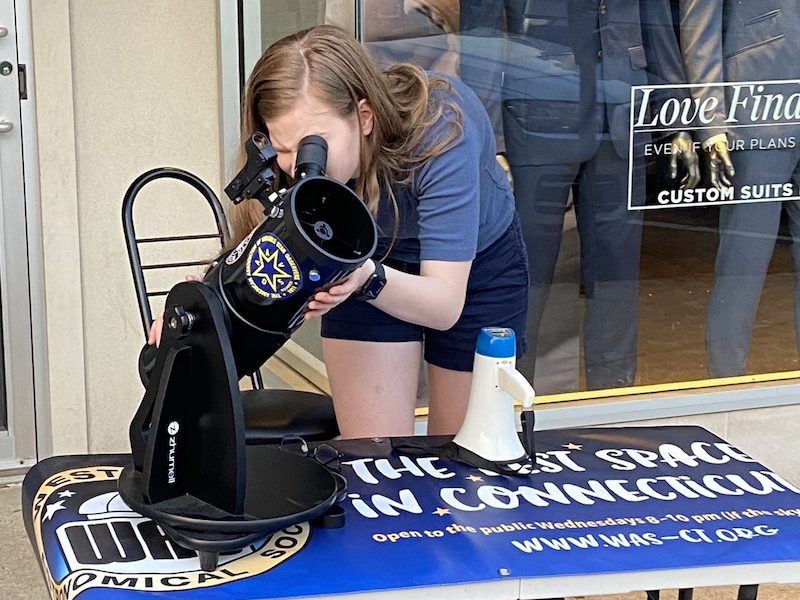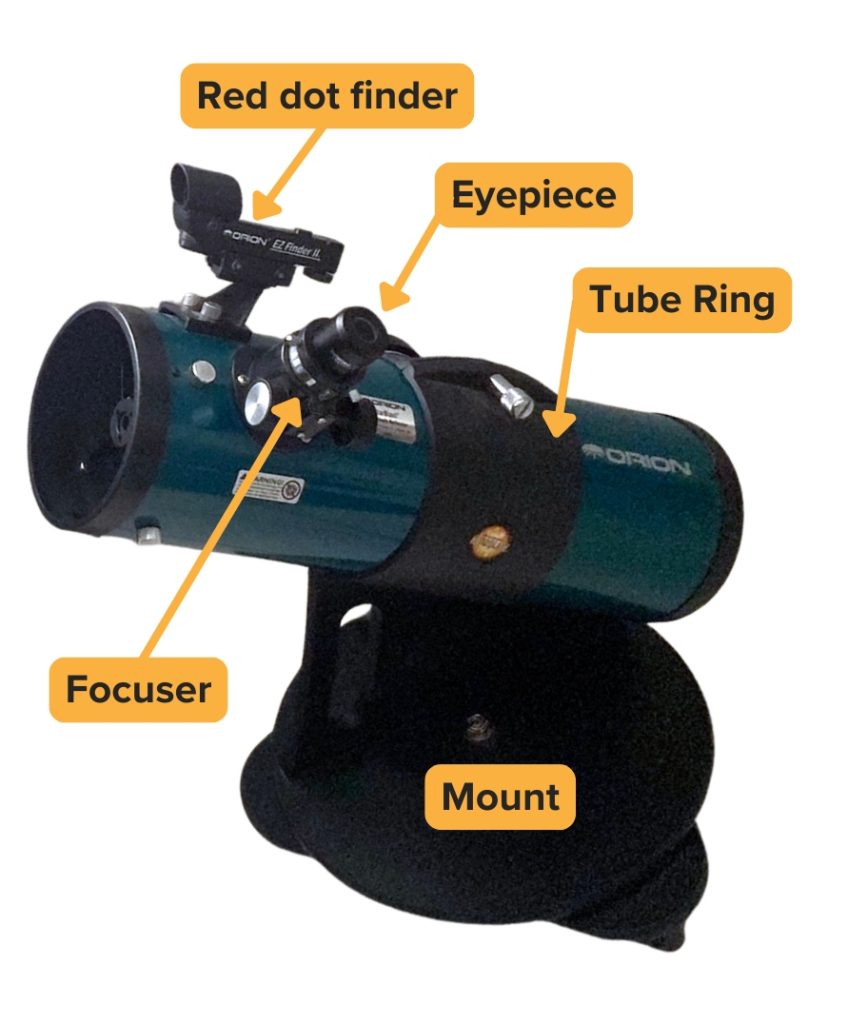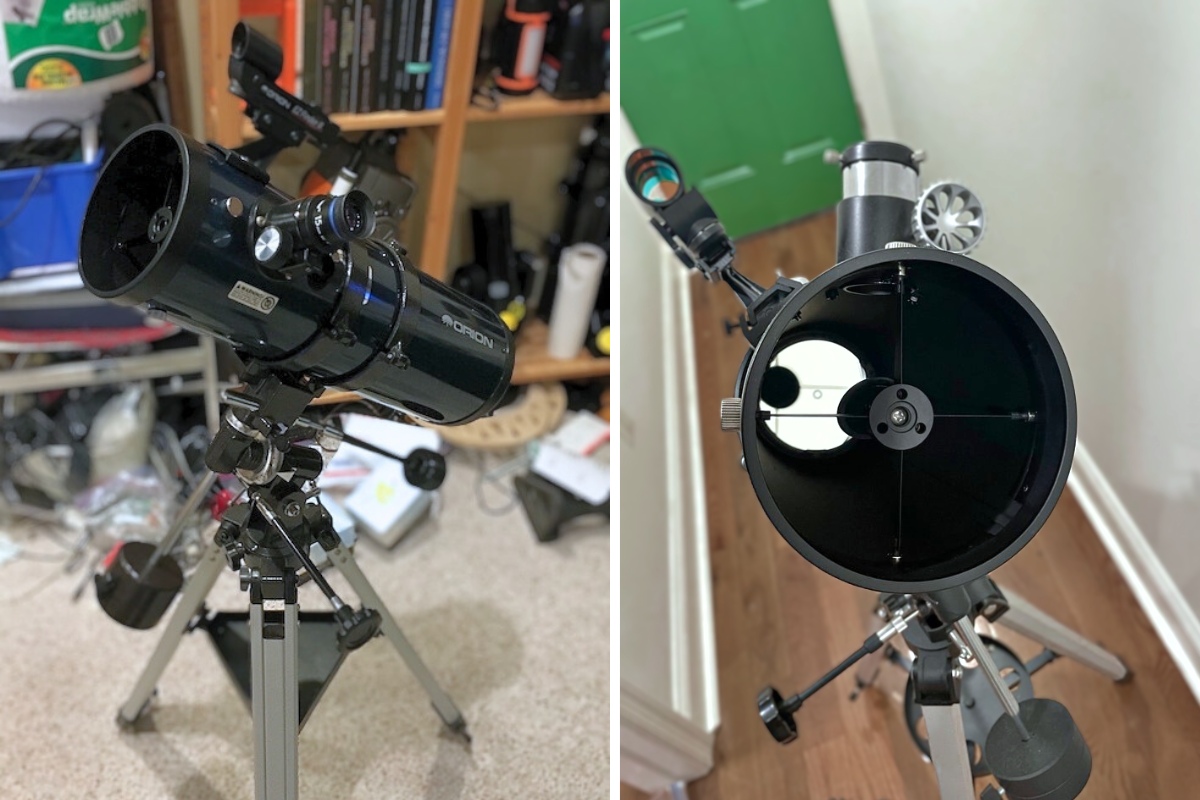Optical Performance Of Starblast 4.5
The Orion StarBlast 4.5 Astro is a Newtonian reflector with a 4.5ʺ aperture, a focal length of 450mm and a focal ratio of f/4.
Originally designed to compete with the sadly-discontinued Edmund Astroscan, the StarBlast 4.5 Astro excels as a wide-field-of-view telescope due to its fast focal ratio of f/4. If you don’t know, the lower the focal ratio of the telescope, the greater its field of view with any given eyepiece. If I use one of my 32 mm Plossl eyepieces or a 24 mm wide-field eyepiece (both are not included in the package), the Orion 4.5 Astro offers me nearly 4° field of view (that’s eight full moons across!).
Both the optical tube and mount of this scope are identical to Zhumell’s Z114, the other 4.5″ tabletop telescope that I highly recommend.

While primarily a wide-field instrument, the StarBlast performs pretty well on the Moon and planets, much better than the 60-90mm refractors that frustrate me whenever I see them being cited as good beginner scopes. And of course, it’s no contest when it comes to deep-sky objects, thanks to its wide field of view, which is ideal for observing deep-sky objects that span a substantial portion of the sky.
The Starblat 4.5 Astro does need collimating, but that’s an easy task. The focuser is a standard 1.25” rack-and-pinion unit.

The StarBlast attaches to its mount with a simple clamping tube ring, as seen in the above picture, allowing us to slide the tube back and forth and rotate it. For mounting it on a full-sized equatorial or alt-azimuth mount, you’ll need a pair of tube rings and a dovetail plate that the 4.5 Astro doesn’t have.
The Fair Set of Eyepieces, But With Areas to Expand to
The StarBlast 4.5 Astro includes two eyepieces: 20mm (23x) and 10mm (45x) oculars, which to me seem to be of some variant of the Kellner or Plossl eyepiece design. They certainly work well, as I’ve tested.
But I’d still recommend you buy a short-focal-length eyepiece (for example, a 6mm Goldline or Redline eyepiece for 75x magnification) to get reasonably magnified planetary views out of the StarBlast’s short 450 mm focal length. A cheaper 2x Barlow lens will then allow you to double that power from 75x to 150x, which is what I’d consider to be the limit of what the StarBlast can handle.
Also, if you can get a wide-angle eyepiece in the 25mm range, it will give you a wider and slightly sharper view than the stock 20mm eyepiece does. For example, a 25mm Plossl provides 18x and a 3-degree field of view. A 25mm Agena Starguider, while expensive, will deliver sharper stars at the edges and extend the field out to about 3.3 degrees.
You could add in additional eyepieces in the 9–15 mm range to further extend your magnification options. But I’m of the opinion that a good high-power eyepiece and a good 24-26mm eyepiece for the maximum possible field of view are all you probably need with the StarBlast.
The Adequate Red Dot Finder and the Useless Moon Filter
As with most beginner scopes, the StarBlast 4.5 Astro is provided with a red dot finder for aiming—more than adequate given the telescope’s ultra-wide field of view.
A 13% transmission “Moon filter” is also included. I see this as a silly piece of glass that does nothing but slightly blur and pointlessly dim my view of the Moon. The light from the moon, while dazzling, cannot actually harm our eyes, even when we’re using a very large telescope.
A Tabletop Dobsonian Mount That Just Works
The StarBlast 4.5 Astro, when it was first introduced in the early 2000s, was a pioneering scope for introducing the tabletop Dobsonian mount to the world.
While not a true “Dobsonian” due to the single-sided bearing, which doesn’t use any Teflon pads, the tabletop mount of the StarBlast is lightweight, compact, easy to aim, and extremely cheap to construct.
I’ve also noticed that the Orion Starblast 4.5 Astro’s mount has a wider footprint than some competing models, which makes it more steady and less prone to being knocked over.
However, you’ll need a milk crate and a chair to comfortably use it. A Rubbermaid bin or similar will also work as a stand, but it will hamper the scope’s portability. Sticking the scope on top of a bar stool or car hood also works in a pinch, or you could make a custom stand/tripod for it pretty cheaply.
Aftermarket Accessory Recommendations
A 6mm “gold-line” eyepiece (75x) would be a good replacement for the StarBlast’s abysmal stock 6mm Kellner, and a 2x Barlow lens will allow you to double the power to 150x, which is about the limit of what the StarBlast can handle.
For low power, a 25mm Plossl provides 18x and a 3-degree field of view. A 25mm Agena Starguider, while expensive, will deliver sharper stars at the edges and extend the field out to about 3.3 degrees.
You could add in additional eyepieces in the 9-15mm range to further extend your magnification options, but a good high-power eyepiece and good 24-26mm eyepiece for the maximum possible field of view is all you probably need with the StarBlast.
Lastly, one other accessory you might want to pick up is Orion’s UltraBlock UHC filter. It doesn’t “filter out” light pollution but rather increases contrast on nebulae making them appear brighter against the background and bringing out subtle details. This filter works great with the StarBlast, which will show you huge swaths of sky containing regions like the North America, Veil, Lagoon, Trifid, Swan, and Eagle Nebula. Even under a dark sky, the UHC brings out more contrast by darkening the sky background.
What can you see?
The StarBlast is optimised for wide field of view observations. It’s primarily made for low-power viewing of nebulae and star clusters. That being said, it’s a pretty good lunar and planetary instrument too.
Deep Sky Viewing
- Even from the suburbs, the Veil Nebula is fantastic with an oxygen-III or UHC filter.
- Bright emission nebulae like Orion, the Lagoon, and the Swan look magnificent, especially from dark skies or with a UHC filter.
- The Milky Way is very fun to explore in both the summer and winter.
- Open clusters are a joy with this telescope. Under dark skies, the many dark nebulae that cross the summer Milky Way are great, challenging objects to hunt for with the StarBlast.
- The Andromeda Galaxy’s dust lane is an easy catch with a wide-field scope like the StarBlast, though few other galaxies present any meaningful detail due to the StarBlast’s small aperture.
Planetary Viewing
- At high magnification, Jupiter’s Great Red Spot and cloud belts are no problem. You may just be able to spot Jupiter’s moons and their shadows crossing the planet.
- Saturn’s Cassini Division is easy to spot on a night of good seeing, as are a few of its brightest moons.
- Venus’ phases are easy, and Mars will show a few dark regions and the ice cap when it’s at or near opposition.
- Uranus and Neptune, if you can find them, are little more than star-like bluish dots with the StarBlast.


